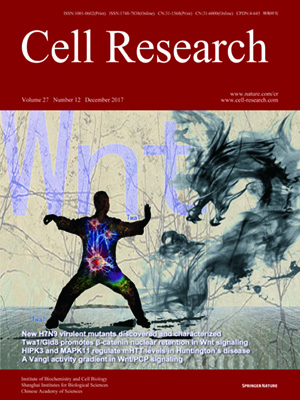
Volume 27, No 12, Dec 2017
ISSN: 1001-0602
EISSN: 1748-7838 2018
impact factor 17.848*
(Clarivate Analytics, 2019)
Volume 27 Issue 12, December 2017: 1441-1465 | Open Access
ORIGINAL ARTICLES
Suppression of MAPK11 or HIPK3 reduces mutant Huntingtin levels in Huntington's disease models
Meng Yu1,*, Yuhua Fu1,*, Yijiang Liang1,*, Haikun Song1, Yao Yao1, Peng Wu1, Yuwei Yao1, Yuyin Pan1, Xue Wen1, Lixiang Ma2, Saiyin Hexige1, Yu Ding1, Shouqing Luo3 and Boxun Lu1
1State Key Laboratory of Medical Neurobiology, Huashan Hospital, School of Life Sciences, Collaborative Innovation Center for Genetics and Development, Fudan University, Shanghai 200438, China.
2Department of Anatomy and Histology & Embryology, Shanghai Medical College, Fudan University, Shanghai 200032, China.
3Peninsula Schools of Medicine and Dentistry, Institute of Translational and Stratified Medicine, University of Plymouth, Research Way, Plymouth, PL68BU, UK.
Correspondence: Boxun Lu,(luboxun@fudan.edu.cn)
Most neurodegenerative disorders are associated with accumulation of disease-relevant proteins. Among them, Huntington disease (HD) is of particular interest because of its monogenetic nature. HD is mainly caused by cytotoxicity of the defective protein encoded by the mutant Huntingtin gene (HTT). Thus, lowering mutant HTT protein (mHTT) levels would be a promising treatment strategy for HD. Here we report two kinases HIPK3 and MAPK11 as positive modulators of mHTT levels both in cells and in vivo. Both kinases regulate mHTT via their kinase activities, suggesting that inhibiting these kinases may have therapeutic values. Interestingly, their effects on HTT levels are mHTT-dependent, providing a feedback mechanism in which mHTT enhances its own level thus contributing to mHTT accumulation and disease progression. Importantly, knockout of MAPK11 significantly rescues disease-relevant behavioral phenotypes in a knockin HD mouse model. Collectively, our data reveal new therapeutic entry points for HD and target-discovery approaches for similar diseases.
10.1038/cr.2017.113
FULL TEXT | PDF
Browse 1872


